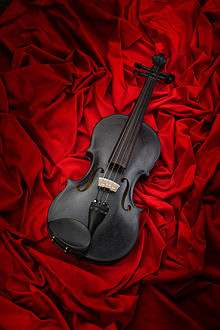Blackbird (violin)

Credit: Gabriel Urbanek

Credit: Gabriel Urbanek
The Blackbird, also called the Black Stone Violin, is a full-size playable violin made of black diabase after drawings by Antonio Stradivari (Stradivarius), but with technical modifications to allow it to be played. The violin was conceived and designed by the Swedish artist Lars Widenfalk. It was named the Blackbird after the common blackbird (Turdus merula) because of its colouring. Stradivari himself often gave his violins names related to birds.[1]
Inspiration
The idea of constructing a musical instrument from stone came when Lars Widenfalk was working on big diabase blocks destined to form part of the artistic embellishment of the Norwegian TV building in Oslo, Norway. These blocks gave off a strikingly beautiful and strong sound during the work with hammer and chisel - it sang like an iron bell. It is also well-known among sculptors and geologists that different rock types have different sounds when being worked.
In 1990 Widenfalk had acquired a small diabase block of highest quality and blackness. It probably came from the quarries of northern Skåne in southern Sweden.[1] It became clear to him that the size was right for an instrument such as a violin. The rock came from his grandfather's tombstone, which had been discarded after a joint family grave had been established.[2] What made Widenfalk start to work on a violin was the desire to discover how far stone, in this case diabase, could be pushed as an artistic material, and he turned it into the world's first playable stone violin.[1]
Construction
Diabase is a deep black plutonic rock with a dense and finely crystalline structure. The rock used for the belly and neck of the violin is about 1.6 billion years old. However, the tombstone was not large enough for the whole violin. Therefore, the back plate was made of another stone, a porphyritic diabase, about 1.9 billion years old, from the province of Härjedalen in south central Sweden.[1] The stone violin is constructed to the designs of Stradivarius, but it uses Widenfalk's own technical modifications to allow it to be played. It weighs only 2 kilograms and took two years to construct, being completed in 1992.
The sound box of the violin is only 2.5 mm thick. It was made with highest precision and the sound box was constructed with sound-holes, back and graceful scroll. The ribs (sound box wall) were made in one piece by first sawing out a 30 mm thick plate shaped to form the external violin contour. Then the inside was removed using a waterjet and machined with hand tools to create a thin rib, no more than a couple of millimetres thick at its thinnest point. The interior of the box was gilded with gold. The fingerboard is made of ebony. Precision bonding of the sound box parts was done using two component glue and the neck secured with two silvered steel pins where it joins the body. The bridge is formed from a piece of mammoth ivory from Siberia, the yellowest available, symbolising the blackbird's yellow beak[1]
The Blackbird is not the only stone violin; the Czech sculptor Jan Řeřicha, has made some stone violins.[3] They are made from marble, a much softer stone and easier to process than diabase. For the best possible sound Blackbird was made after drawings by Stradivarius and weighs only 2 kg, while the marble violins weigh between 3.6 and 6.5 kg.[4]
Performance
The Swedish composer Sven David Sandström composed music specifically for the instrument.[5] The music's first public performance on the Blackbird took place in the Swedish Pavilion at the 1992 Seville Expo in Spain. In the same year the violin was blessed by Pope John Paul II in Rome.[6] Since then, it has been played in many places including Dubai,[7] Luxembourg, Monza, Milan, Nuremberg, Oslo,[8] Prague, Stockholm and Washington. A video from Face II Face,[9] the Lars Holm and Lars Widenfalk art exhibition in Linneanum, Botanical Garden, Uppsala 2009 includes a 30-second segment of a performance on the violin [10]
References
- 1 2 3 4 5 Yman, Bosse. Lars Widenfalk skulptör utan gränser Magasinet Herjedalen. Vinter/vår 2012.
- ↑ Ljungaeus, Diana. 1991. Lars byggde en fiol av morfars gravsten. (unknown: Swedish newspaper)
- ↑ www.janrericha.com/marble-violin (visited: 12 January 2013)
- ↑ www.janrericha.com/certificates (visited: 12 january 2013)
- ↑ Broman, Per F. 2012.
- ↑ Wallgren, Måns. 1992. Vãlsignad av påven. Dagens Nyheter. (swedish newspaper)
- ↑ As a work of art it is unique. Gulf News. 1 February 2005. (visited: 4 August 2012)
- ↑ Spiller på stein. Aftenposten. 16 October 2006. (visited: 4 August 2012)
- ↑ Face II Face - Lars Holm and Lars Widenfalk - Art exhibition in Linneanum, Botanical Garden, Uppsala 2009
- ↑ Lars Holm and Lars Widenfalk exhibition 2009, Botaniska trädgården, Uppsala 2009
Further reading
- Broman, Per F. 2012.Svenska tonsättare: Sven-David Sandström. Stockholm: Atlantis,
- Tovik, Arne. Reiste seg etter hærverket. Varden. Kultur. 5. June 2005. Skien/Oslo. 2005. Page 42. (Norwegian) html
- Kalsi, Jyoti. As a work of art it is unique. Gulf News. (tabloid) 1. February 2005. Page 5. (Dubai) html
- Yman, Bosse. Lars Widenfalk skulptör utan gränser. Magasinet Herjedalen. Vinter/vår 2012. Page 62-69. (Swedish) pdf
External links
- Blackbird: The Black Stone Violin (Lars Widenfalk)
- Blackbird the Black Stone Violin - The volinist Guo Jia Yin play on the stoneviolin